 |
| The Art of Effective Communication Through Email. |
Effective communication is beneficial to planning an
instructional design project. How can
project managers effectively communicate with team member? Face-to-Face, online communication and
voicemail are the common ways of communication.
As I listened to the multimedia program “The Art of Effective
Communication” (Laureate-media.com), I can clearly perceive how effective one
way of communication may be more acceptable than others.
As an asynchronous learner, I use multimedia sources
and email for much of my communication.
As I was reading the email information, the message was well displayed
and I comprehended the reasoning for the email.
The participant needed some reports in order to complete her deadline of
producing work. Was the email effective
in relaying the message? I would say yes
because the email was direct and to the point. The only negative aspect to
email is that people may not respond. I
truly believe “if you find you have to write a very long email to do justice to
the subject, you may be better off having a face to face talk. Long emails tend to
breed long replies” (People Communicating, 2009-2010). Even when I communicate to my cohort, project
team or coworkers, I will send direct and to the point emails. Most of the time the emails turn into instant
messaging because the conversations are so straightforward. In this way, I can identify with this method. With voice-mails, there is a similar
comparison because voice-mail messages tend to be direct also.
| |
 |
| Communicating Through Face-to-Face Conversations. |
Any time clients, internal and external customers, and stakeholders are involved in a project there are going to be multiple forms of
communication. Is one communication more
effective that others? Probably not, but
communication has to depend on the clientele, the environment and the
stakeholders. It is more likely that
multiple types of communication will be prevalent in business. Communicating by email allows project members
to be direct with ongoing progress and issues.
Voicemails enables the client to listen to the presentations of any
concerns or updates with project needs.
Most of all face-to-face allows a visual that sets a precedence over the
atmosphere of the team. All of these
effective ways of communicating are beneficial to any project. I utilize all forms of commutations when I am working
on a project with a team. I have learned
from watching the multimedia program that face-to-face had a lasting impression
because it actually gave the team members, stakeholders, internal and external
clients the ability to watch a team member voice her concerns and request
documents needed for a project or work assignment. The appearance and tonality of her speech
would make a positive impression on a team member as well as a stakeholder.
References
Kramer,
B. E., Mantel, S. J., Meredith, J. R., Shafer, S. M., Sutton, M. M., &
Portny, S. E. (2008).Project management planning, scheduling, and
controlling projects. (pp. 356-370). Hoboken, NJ: John Wiley & Sons,
Inc.
Laureate-media.com. (Producer)
(n.d.). The art of effective communication [Web]. Retrieved from http://mym.cdn.laureate-media.com/2dett4d/Walden/EDUC/6145/03/mm/aoc/index.html
People Communicating. (2009-2010). Effective
email communication. Retrieved from http://www.people-communicating.com/effective-email-communication.html



